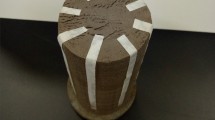Abstract
Numerical analyses based on Finite Element Method (FEM) to solve geotechnical problems are carried out using software implementing various soil models. Currently, Hardening Soil Model (HS) is often used in the geotechnical engineering practice. One of the parameters describing the model is the unloading-reloading (Eur) modulus. This paper presents triaxial test results of cohesive soils aimed at determination of unloading-reloading (Eur) modulus. Based on test results, empirical correlations for evaluation of Eur modulus were determined. The correlations determine Eur modulus on the basis of plasticity index and vertical effective stress.
Access provided by CONRICYT-eBooks. Download conference paper PDF
Similar content being viewed by others
Keywords
1 Introduction
Hardening Soil Model (HS) was formulated in 1999 by Schanz et al. [4]. Its modification, which includes elastic behaviour of soil for the small strain (HSS) was presented by Benz [1]. Both models are among the most popular constitutive models used in the geotechnical practice.
Strain parameters of the model are defined in Fig. 1. The manual [3] and publication [2] listed in the bibliography below, proposed the relationship between Eur and E50 as Eur/E50 = 3. However, Obrzud [2] and Truty [5] noted that Eur/E50 ratio should be higher.
Below an empirical equation for Eur modulus calculation based on effective stress and plasticity index (PI) is proposed.
2 Test Methodology and Analyses
2.1 Triaxial Tests
The tests were carried out on undisturbed soil samples in GEOTEKO’s laboratory. The triaxial tests included the following stages: back pressure saturation, isotropic consolidation and strain controlled drained shearing along standard stress path i.e. with constant cell pressure and increasing vertical stress.
2.2 Analyses
The analyses were performed using the results of triaxial tests carried out in terms of effective stress of values higher than in situ stress. Below, Fig. 2 shows a relationship between Eur modulus and mean effective stress at the end of consolidation stage (\( {\text{p}}_{\text{c}}^{'} \)) taking into account plasticity index value.
The relationship between Eur and \( {\text{p}}_{\text{c}}^{'} \) can be described by the following general formula:
Parameter (a) in Eq. (1) changes together with plasticity index variations. Figure 3 shows the relationship between parameter (a) and plasticity index.
Based on the above, Eur moduli values can be calculated from the following formula:
Using the proposed empirical formula, Eur moduli were determined and compared with the relevant values resulting from the laboratory tests (Fig. 4). In conclusion one may declare that a significant part of Eur value determined by empirical formula is within ±30% of Eur value determined in the laboratory tests. Thus it seems to form a better approximation than the ratio Eur/E50 = 3 which was mentioned earlier.
3 Conclusions
The following conclusions can be drawn on the basis of the performed tests and analyses:
-
as soil plasticity index increases, the influence of effective stress on Eur value becomes smaller.
-
the best correlation between Eur modulus and effective stress was obtained for soils of plasticity index smaller than 30%.
-
the proposed empirical relationship allows calculating Eur modulus on the basis of plasticity index (PI) and average effective stress (\( {\text{p}}_{\text{c}}^{'} \)) values. A significant part of Eur value determined from the proposed empirical formula is included within the range of ±30% of Eur value determined in the laboratory tests.
The analyses presented in the paper were carried out within R&D activity of Geoteko Geotechnical Consultants Ltd. The a/m works resulted also in the proposal of other empirical formulas for estimation of geotechnical parameters. They will be presented in the next papers to be published.
References
Benz, T.: Small-strain stiffness of soils and its numerical consequences. Ph.D., Universitat Stuttgart (2007)
Obrzud, R.: On the Use of the Hardening Soil Small Strain Model in Geotechnical Practice. Elmepress International, Lausanne (2010)
PLAXIS: Material Models Manual (2017)
Schanz, T., Vermeer, P., Bonier, P.: Formulation and verification of the hardening soil model. In: Beyond 2000 in Computational Geotechnics. Balkema, Rotterdam (1999)
Truty, A.: Hardening soil model with small strain stiffness. Technical report 080901, Zace Services Ltd., Lausanne (2008)
Author information
Authors and Affiliations
Corresponding author
Editor information
Editors and Affiliations
Rights and permissions
Copyright information
© 2018 Springer Nature Switzerland AG
About this paper
Cite this paper
Tymiński, W., Kiełczewski, T., Daniluk, H. (2018). Hardening Soil Model - Influence of Plasticity Index on Unloading - Reloading Modulus. In: Wu, W., Yu, HS. (eds) Proceedings of China-Europe Conference on Geotechnical Engineering. Springer Series in Geomechanics and Geoengineering. Springer, Cham. https://doi.org/10.1007/978-3-319-97112-4_20
Download citation
DOI: https://doi.org/10.1007/978-3-319-97112-4_20
Published:
Publisher Name: Springer, Cham
Print ISBN: 978-3-319-97111-7
Online ISBN: 978-3-319-97112-4
eBook Packages: EngineeringEngineering (R0)








